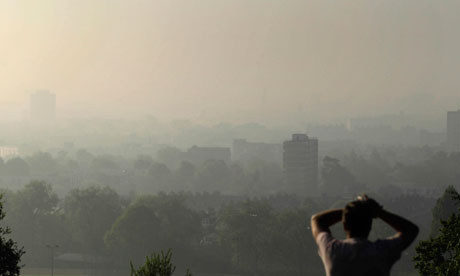Researcher Smackdowns Gas Industry Over Smog Study Criticisms
 You may remember that Dr. Jay Olaguer with the independent Houston Advanced Research Center (HARC) set off a bit of a controversy last month with publication of a new study showing that gas mining activity in DFW was "significantly" increasing local smog levels 2 to 8 miles downwind. His report focused on flares and compressors and showed that just one facility could increase ozone levels by 2-3 parts per billion. This was another invaluable piece of evidence pointing to the impact of under and un-regulated emissions from the gas mining industry
You may remember that Dr. Jay Olaguer with the independent Houston Advanced Research Center (HARC) set off a bit of a controversy last month with publication of a new study showing that gas mining activity in DFW was "significantly" increasing local smog levels 2 to 8 miles downwind. His report focused on flares and compressors and showed that just one facility could increase ozone levels by 2-3 parts per billion. This was another invaluable piece of evidence pointing to the impact of under and un-regulated emissions from the gas mining industry
It didn't take long for the gas industry to have it usual knee-jerk response – deny everything. Even if you have to misrepresent the original research and lie about its conclusions. First, the PR specialists at Energy in Depth responded without even reading the study. Dr. Olaguer's full response to that piece of hackary is located here.
Next Ed Ireland, PR director of the Barnett Shale Energy Education Council did another whack job trying to discredit Olaguer's work. His falsehoods and mistakes are rebutted point by point here.
Industry charged that the model used by Dr. Olaguer wasn't peer-reviewed. It was – in three different journals.
Industry charged that all the smog-forming Volatile Organic Compounds examined by Dr. Olaguer were treated the same in the model. Wrong again. Highly reactive VOCS – the ones most likely to cause smog problems, are treated in much greater detail than the standard model used by TCEQ and others.
Industry charges the flare emission factors used by Dr. Olaguer are based on the 2010 TCEQ Flare study. They are not.
Industry then falls back on the "we've got so many TCEQ monitors that say everything is hunky-dory" argument. HARC responds by saying that "the TCEQ monitoring network is too sparse to determine the true impact of oil and gas site emissions on air quality." Amen.
HARC's study is unique in that it started from scratch and didn't assume anything – unlike the approach TCEQ and the industry uses. "The HARC model is, in fact, the only model currently available that can tractably assess ozone impacts at very high spatial resolution near sources." TCEQ and the industry don't have a credible response to this study because they've never looked at the same phenomena that Dr. Olaguer is examining.
Pollution from gas drilling and processing is setting back progress in DFW's fight for better air quality. There are no more excuses for local officials to hide behind. Gas may be cleaner when it burns in a power plant, but North Texas has become the natural gas equivalent of Appalachia where the local environment and public health is sacrificed for industry profits.
